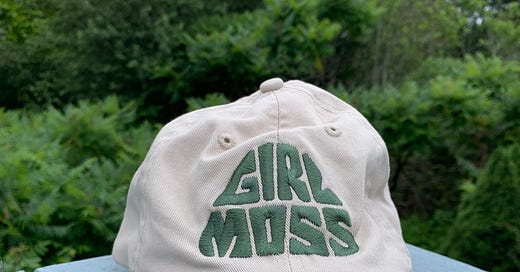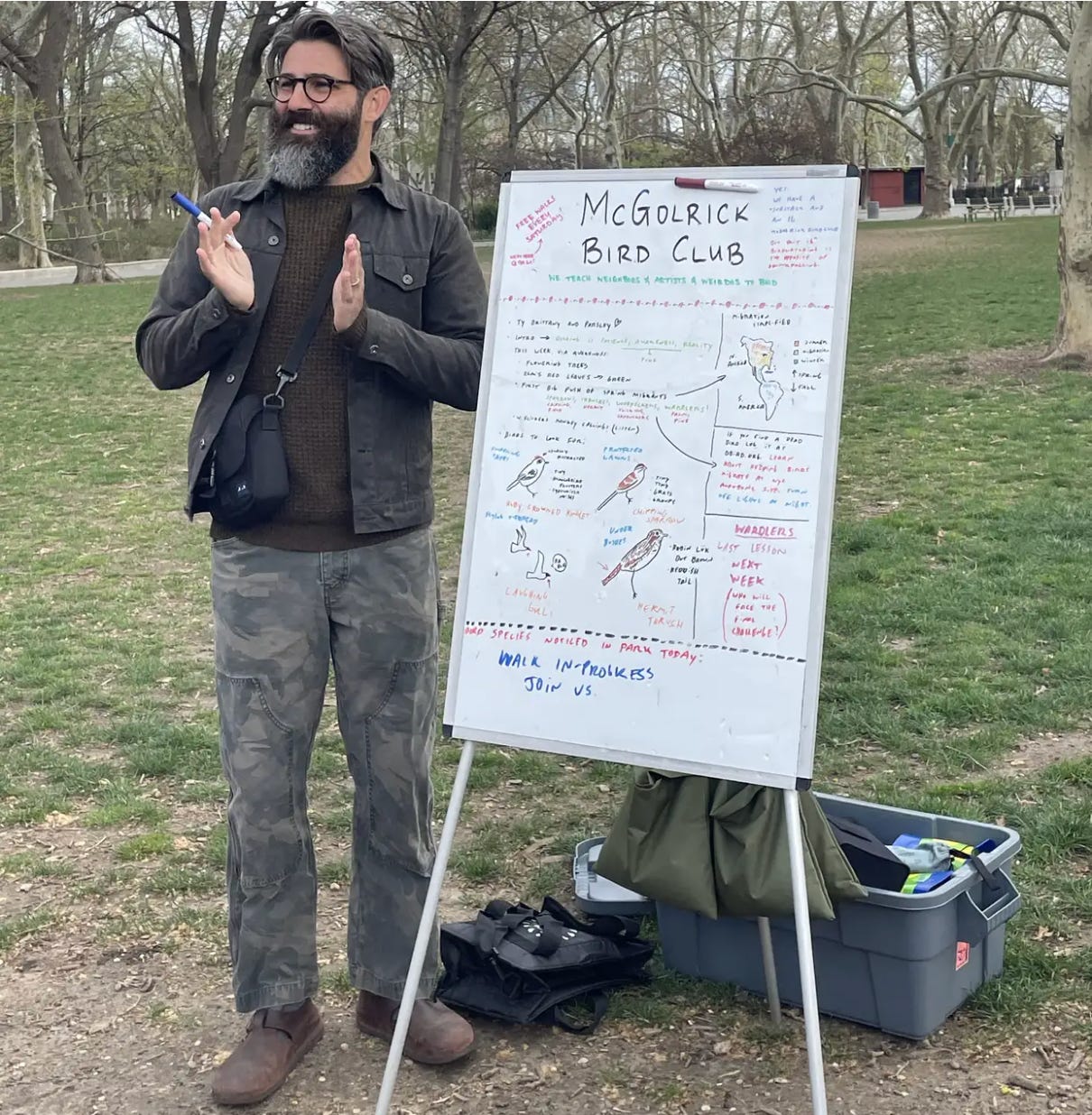The
in Greenpoint, Brooklyn convenes every Saturday to participate in a quiet morning of birdspotting. The group’s charismatic leader - Michael Lombardo - was inspired to start the club after reading Jenny Odell’s field guide to anti-productivity: “How to Do Nothing”. According to the community’s Instagram account, the birding collective attracts local neighbours, artists, skaters and ‘weirdos’ who unite on the weekends to spot American Robins, Northern Cardinals and Blue Jays. “Tongue kiss the natural world, beak first!”, the bird club’s about page proclaims.A profile in The Gothamist mentions that Lombardo wears camo pants and Birkenstock Bostons and likes to say things like “birding is punk”. But could something as quiet, serene and wholesome as birdwatching really be regarded as ‘punk’?
Does the act of sitting in a park, patiently looking through a pair of binoculars and reading through field guides really deserve to be described with the same adjective usually reserved for angsty hardcore punk music, crusty anarchos and angry outcasts with ripped leather jackets?
If one considers punk as anything defiantly anti-capitalist, anti-establishment, anti-mainstream - then the answer is actually yes.
While the aura of ‘punk’ may have traditionally been about being harder, louder, faster - with all the perpetual exhaustion from the constant, ever-accelerating intensity of modern life, the notion of softer, slower, quieter has instead turned into this era’s most radical act of rebellion. Lombardo was right - in 2024, birding is punk as f*ck.
Forget the aggressive and distorted sound of Sex Pistols, Black Flag and Bad Brains. If you want to fight the system, instead you have to keep quiet and listen for the sounds of birdcalls, whispers and rustling leaves. The weirdos and skaters are no longer interested in shouting obscenities and smashing windows, instead they want to leave their phones at home, be present and touch grass.
The idea of ‘slowing down’ - once derided as weak and lame, a feeble surrender to apathy - has increasingly taken on an empowering and commanding vibe. When speed is the status quo, the rebels are the ones that dig their heels in, while everyone around them keeps on running the race. As essayist Pico Eyer once argued, stillness has become the one thing we need and crave in our accelerated lives:
“In an age of speed, I began to think, nothing could be more invigorating than going slow. In an age of distraction, nothing can feel more luxurious than paying attention. And in an age of constant movement, nothing is more urgent than sitting still.”
From this urgency; the urgency to put a stop to the artificial, manufactured speed of technology - meditation groups, birdwatchers and devoted slackers are emerging.
In the long lineage of modern punk subcultures, from the King’s Road punks of the 70s through to the ‘low life, high tech’ cyberpunks of the 90s and radically hopeful solarpunks of the noughties, this is the rise of the genre’s next countercultural iteration: slowpunk .
This loosely connected constellation of collectives and behaviours - fighting against the unbearable speed of modern life - is quickly becoming the defining underground movement of the modern zeitgeist.
Often, it’s small, but ultimately bold acts of resistance that point at a growing resentment: a bitter, angry realisation that our attention and energy are finite resources that shouldn’t be wasted so cheaply. A resentment rooted in the most cunning lie ever weaved by the tech industry : the promise that software, apps and phones were going to free us and make our lives easier. Instead, they made everything unbearably hectic. As
argues in an essay about this illusion of convenience: “The basic rule is this: technology doesn't make our lives easier. It makes them faster and more crammed with stuff.”So now, there’s the growing phenomena of people aggressively beginning to revoke other people’s access to their attention online. They’re taking digital sabbaticals, setting strict communication windows for checking and replying to messages, ignoring or archiving messages unless they’re from known people, turning off all app notifications. They are featuring “protecting my time” disclaimers on personal sites. Writer
coined this set of increasingly prevalent behaviours as “ping minimalism”; small acts of digital resistance underpinned by the idea that attention is the most valuable asset we have, and must be protected at all cost.Pushing back against the unrelenting speed of capitalism can also take on softer, yet equally provocative forms that imbue the symbolic slowness of nature. A decade ago, the closest thing the corporate world had to a punk movement was the rise of the ‘Girlboss’, a celebration of female empowerment and glamorisation of hustle culture, originally popularised by entrepreneur Sophia Amoruso. But after years of devoted grind mentality, leaving in it’s wake a scorched trail of burnt-out office workers, the modern zeitgeist has now pivoted towards another, very different aspirational archetype: Girlmoss.
Girlmoss was originally coined in a tweet by X user MeganJKaleita, where they proclaimed:
“I don’t want to girlboss. I want to girlmoss. Grow on a cool damp stone in the forest, feel the breeze and hear the birds, be harvested by gnomes and turned into clothing. Girlmoss”
While the Girlboss aspired to ascend the corporate ladder and max out productivity levels, the Girlmoss yearns for a more mellow life that moves at the unhurried speed of forest floor flora and fauna. Girlmoss yearns for WFH fake email jobs and midweek lunchtime Pilates. Or they decide to ditch the urban rat race altogether, escaping to a cabin in a beautiful place out in the country.
Slowpunk has an aversion to city life, because city life forces us to move at an unnatural speed, out of sync with our body clocks, out of sync with nature, inducing a sense of disorienting, tech-induced jetlag.
Slowpunk seeks to resolve this internal misalignment by leaning in closer to the organic rhythm of nature.
unearthed a study in his Creative Destruction newsletter that illustrates how the natural environment can offer a very potent solution to the increasingly widespread feelings of time scarcity caused by contemporary urban lifestyles. The research found that feeling ‘in touch’ with nature expands our perception of “temporal duration”. In other words, time feels longer, stretched out, when we are immersed in natural settings, in contrast to the compressed timelines of urban gridlock. It proved something we’ve all inevitably experienced at some point: how a 30 minute walk in the city goes by in a blink of an eye, while a 5 minute stroll in nature can feel like a mind-bending eternity.But Slowpunk is about more than just re-adjusting our pace to the speed of nature. It’s also about slowing down the rhythm of our ambition to a speed that feels more tender-hearted and human. Every counterculture has it’s soundtrack that points at a certain lifestyle ethos - and while punk movements of the past have been accompanied by angsty songs that reflect a sense of restlessness, that soundtrack is changing. It has recently been reported that young people have attached themselves to far softer odes that oppose the relentless intensity of modern life.
Billy Joel's 1977 hit Vienna, for example, has apparently become Gen Z's new anthem. With it’s refrain of “slow down, you’re doing fine”, it’s said to soothe a specific kind of malaise, reminding kids raised on the immediacy of social media and the restless news cycle to take a step back.
Joel has said that the song reminds listeners that “you don’t have to squeeze your whole life into your 20s and 30s trying to make it, trying to achieve that American dream, getting in the rat race and killing yourself. You have a whole life to live.”
Joining the slowpunk movement can take many forms. Sometimes it’s about escaping the rat race and resisting the urge to rush forward. Sometimes its a complete identity shift. Sometimes its smaller acts of resistance, like turning off your app notifications. But fighting through the collective fear of being left behind - going slower than everyone else - is never easy. That’s the nature of being a punk; it’s a commitment to take a stand and risk societal rejection. That’s what it takes to fight for your right to stand still and enjoy life at a slower pace.
Footnote:
The 2nd issue of Playground Magazine - a lovely new bi-annual print publication for creative minds by
- features an essay where I explore the role of imagination in corporate-speak. You can read more about the issue and pre-order below:
and big shoutout to Ben at BT Digital for the new idle gaze design <3









looove the new logo!!
Great read. Thank you 🙏